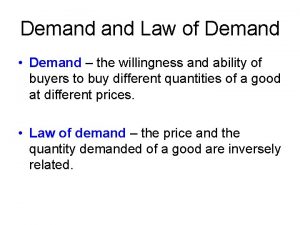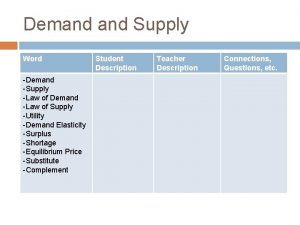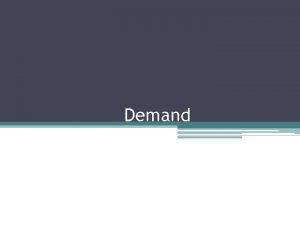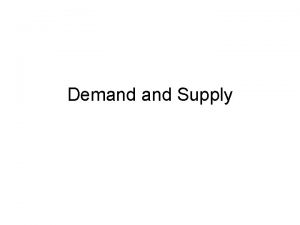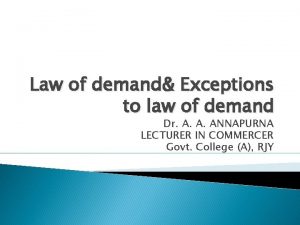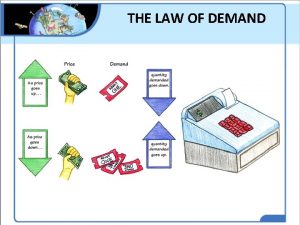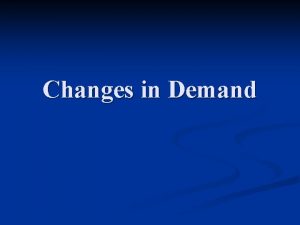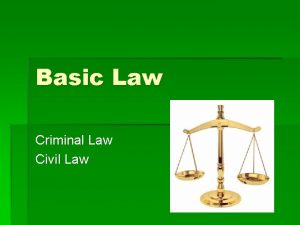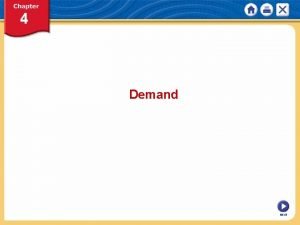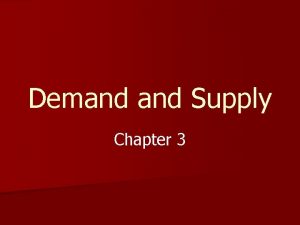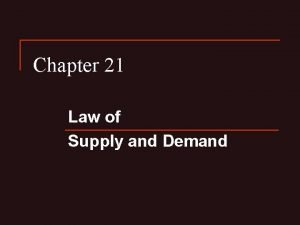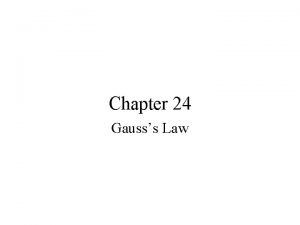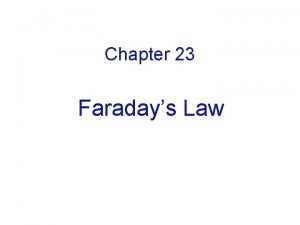DEMAND Chapter 4 The Law of Demand Demand








































- Slides: 40

DEMAND Chapter 4

The Law of Demand �Demand- the willingness to buy a good or service and the ability to pay for it. �Demand is also desire for a good/service but you hafta pay for it �Demand- the amounts of a product consumers are willing and able to purchase at each price �_______ is the major factor that influences demand

The Law of Demand �States that when prices go down, quantity demanded increases. When prices go up quantity demanded decreases. �P �P Q Q �This is an inverse or negative relationship

Demand Schedule �Is a listing of how much of an item an individual is willing to purchase at each price. �Basically it’s a table

Market Demand Schedule �Is a listing of how much of an item all consumers are willing to to purchase at each price. �How do we get these numbers? �Lets do one.

Demand Curves �Graphically show the data from a demand schedule �Market demand curve-same as above only for a market

Vera Wang �Frustrated when she couldn’t find the wedding dress she wanted. �Created her own style of wedding dresses- more sophisticated gowns (no puffed sleeves or lace flounces) �Celebrities �She created a demand for these sophisticated style dresses �Top wedding dress maker in the country

Why do demand curves slope downward? �Law of diminishing marginal utility- the marginal benefit of using each additional unit of a product during a given period will decline. �Or- each buyer get less and less satisfaction from another unit consumer- so price must fall for consumers to want to buy more. �Break it down: �Marginal= one more �Utility= satisfaction

Patterns of consumer behavior �Income effect- the change in the amount consumers buy because their income changes �Or- a lower price increases the purchasing power of a buyers money--so you can afford to buy more- the dollar goes farther. �Exs? �Buy more books at 7 dollars than 15. (feel $8 richer)

Patterns of behavior �Substitution effect- buying a substitute good when the item you originally wanted is more expensive. �Buy a magazine b/c the hardback book cost was too high �Give ‘em some examples

Change in Demand �Occurs when something (determinants of demand) prompts consumers to buy different amounts at every price. �Shifts the demand curve right or left �Ex. High unemployment prompts consumers to by less goods at each price level.

Shifts �Shift to the left______ �Shift to the right_____

Change in Quantity Demanded �Is an increase or decrease in the amount demanded because of a change in price. �This is just a move from one point to another on the demand curve �We are NOT moving the curve

Income -----Yeah Money �Income changes peoples ability to buy things (goods/services) �Snow remover-get less snow- smaller paycheck- can’t buy as many baseball cards ----Demand curve shifts to the ____?

Some goods… �Normal goods- goods that consumers demand more of when their incomes rise �Luxury cars �Examples? �Inferior goods- goods that consumers demand less of when their incomes rise �Examples? �Ramen noodles

Number of Buyers (Market Size) �The number of consumers increases or decreases the demand �The more people in a market or area of the country the demand for products generally goes up �Baby boom- retirement communities increased

Consumer Tastes and Preferences �Popular goods are in high demand �Unpopular goods that aren’t cool are demanded less �Tastes change quickly �Clothing (What’s In)

Consumer Expectations (Expected Prices) �Your expectations of how much a product will cost in the future determines if you buy it now or later. �Expectations that gas will be going up leads to people trying to “beat” the price rise which increases demand.

Substitute Goods �Are goods and services that can be used in place of each other. �Products are interchangeable �An increase in the price of one good will increase the demand for the second good (substitute) �Example…. �Ben & Jerry’s and Blue Bunny Ice cream

Complementary Goods �Goods that are used together, so a rise in demand for one increases the demand for the other �If the price of one product changes, demand for both products will change in the same way. �They go together �Cd’s and CD players

Some add another determinant �Environmental, timing, or season �Time of the year affects demand �Christmas trees in July �Snow blowers in FL

Determinants of Demand �TIN-SE �In the night pumpkins explode �Others? ? ? ? �Incomes �Number of Buyers �Tastes/preferences �Consumer expectations/ Expected prices �Price of related goods (Complements/Substitutes)

That’s It Ya’ll

Section 3 Elasticity of Demand

Elasticity of Demand � Elasticity of Demand- a measure of how responsive consumers are to price changes � Markets are sensitive to changes in price, but not all increases in price result in a decrease in demand.

Elasticity of Demand � Demand is Elastic if quantity demanded changes significantly as price changes. ◦ The more responsive to change the market is the more likely the demand is elastic. � Demand is Inelastic if quantity demanded changes little as price changes. ◦ Change in price have little impact on the quantity demanded.

How to remember? � How in the world can I remember elastic and inelastic? ? ? ? ? � Think a rubber band…. . � When the quantity demanded increases by a lot, the demand is elastic and the rubber band stretches. � Quantity demanded barely changes—demand is inelastic and rubber band stretches very little.

Real life examples? ? ? � Goods elastic that have a lot of substitutes are ◦ Why? � Elastic--? ◦ Food � Inelastic--? ◦ Insulin ◦ NE football tickets

Elasticity continued � Elasticity of demand for products can change � If we get more substitutes, then, demand might become more elastic. ◦ Cell service –more elastic with more providers � Products are withdrawn, there is less to choose from & demand becomes inelastic.

Here’s a picture

How to remember it? � Inelastic- looks like an I � Elastic- : looks like an E P D C C

Unit Elastic � Demand is unit elastic when the percentage change in price and quantity demanded are the same. � If the price goes up 10% then the quantity demanded will drop exactly 10 % � No good or service is ever really unit elastic

What determines elasticity? Factors/determinents � 1. Substitute goods or services? ◦ No substitute demand tends to be inelastic ◦ Many substitutes tends to be elastic

What determines elasticity � 2. Proportion of Income ◦ The percentage of your income that is spent on goods/services affects elasticity ◦ Ex. Photography=hobby ◦ If the price of camera chips, and fancy lenses goes up, then, you probably won’t spend money on itelastic ◦ But if the price of pencils, or pens rose, you still would buy what you need for school-inelastic

What determines elasticity � 3. Necessity Versus Luxuries � Demand for necessities tend to be inelastic ◦ But people don’t always buy the same quantities they may use substitutes � Luxuries are not essential to your life ◦ Luxury demand tends to be elastic


How to figure Elasticity of Demand � Total Revenue- a company’s income from selling its products � Total Revenue Test- a method of measuring elasticity by comparing total revenues. � Total Revenue= Px. Q


Total Revenue Continued �A drop in a business’s total revenue from a price increase indicates elastic demand. � Changing movie ticket prices from $4 to $5. • • A rise in a business’s total revenue because of a price increase indicates inelastic demand. Say the ticket prices went from $3 to $4.

 Newton's first law and second law and third law
Newton's first law and second law and third law Newton's first law
Newton's first law V=k/p
V=k/p Avogadro's law constants
Avogadro's law constants Hình ảnh bộ gõ cơ thể búng tay
Hình ảnh bộ gõ cơ thể búng tay Frameset trong html5
Frameset trong html5 Bổ thể
Bổ thể Tỉ lệ cơ thể trẻ em
Tỉ lệ cơ thể trẻ em Gấu đi như thế nào
Gấu đi như thế nào Chụp phim tư thế worms-breton
Chụp phim tư thế worms-breton Hát lên người ơi
Hát lên người ơi Các môn thể thao bắt đầu bằng tiếng nhảy
Các môn thể thao bắt đầu bằng tiếng nhảy Thế nào là hệ số cao nhất
Thế nào là hệ số cao nhất Các châu lục và đại dương trên thế giới
Các châu lục và đại dương trên thế giới Công thức tính thế năng
Công thức tính thế năng Trời xanh đây là của chúng ta thể thơ
Trời xanh đây là của chúng ta thể thơ Mật thư anh em như thể tay chân
Mật thư anh em như thể tay chân Làm thế nào để 102-1=99
Làm thế nào để 102-1=99 Phản ứng thế ankan
Phản ứng thế ankan Các châu lục và đại dương trên thế giới
Các châu lục và đại dương trên thế giới Thể thơ truyền thống
Thể thơ truyền thống Quá trình desamine hóa có thể tạo ra
Quá trình desamine hóa có thể tạo ra Một số thể thơ truyền thống
Một số thể thơ truyền thống Bàn tay mà dây bẩn
Bàn tay mà dây bẩn Vẽ hình chiếu vuông góc của vật thể sau
Vẽ hình chiếu vuông góc của vật thể sau Biện pháp chống mỏi cơ
Biện pháp chống mỏi cơ đặc điểm cơ thể của người tối cổ
đặc điểm cơ thể của người tối cổ Ví dụ về giọng cùng tên
Ví dụ về giọng cùng tên Vẽ hình chiếu đứng bằng cạnh của vật thể
Vẽ hình chiếu đứng bằng cạnh của vật thể Tia chieu sa te
Tia chieu sa te Thẻ vin
Thẻ vin đại từ thay thế
đại từ thay thế điện thế nghỉ
điện thế nghỉ Tư thế ngồi viết
Tư thế ngồi viết Diễn thế sinh thái là
Diễn thế sinh thái là Các loại đột biến cấu trúc nhiễm sắc thể
Các loại đột biến cấu trúc nhiễm sắc thể Thế nào là số nguyên tố
Thế nào là số nguyên tố Tư thế ngồi viết
Tư thế ngồi viết Lời thề hippocrates
Lời thề hippocrates Thiếu nhi thế giới liên hoan
Thiếu nhi thế giới liên hoan ưu thế lai là gì
ưu thế lai là gì










































